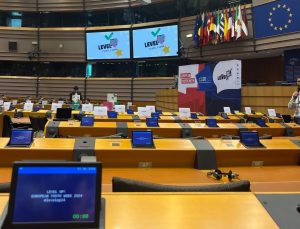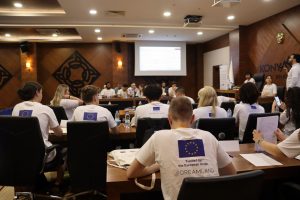Written by Aya Moutawakkil
Reading time: 5 minutes
What is the left-right spectrum?
Radical parties on both the left and right wings have been increasingly gaining electoral popularity in developed democracies. This trend has been occurring gradually over multiple election cycles in Europe. Following recent elections, it’s evident that voters are becoming more radical on both ends of the political spectrum. But why are voters becoming so radical?
In political science, the left-right spectrum is based on the socio-economic distribution within society and the ideologies associated with it. On this spectrum, political parties position themselves differently to adhere to specific market structures and attract voters during their campaigns, where “left” is to found on the left side and “right” is to found on the right side of the continuum.
In this context, “left” typically refers to ideologies focused on equality, justice, and the role of the government in regulating the economy to achieve social goals. Left-leaning voters aim to achieve these socio-economic goals through the redistribution of wealth via progressive taxation, where higher income groups are taxed more heavily to support lower income groups, thereby reducing inequality and ensuring social justice. Overall, the left strives for fair economic competition and equal social justice.
The radical left, however, advocates for more extreme measures. They support rapid changes, such as anti-capitalism, arguing that capitalism inherently leads to social inequality and unfair economic competition. The radical left supports revolutionary reforms and changes, aiming for a complete restructuring of the social and economic systems.
The ‘right’ typically refers to ideologies focused on a free market, individualism, and limited government intervention in the economy. When overall compared to the “left” side the “right” believes that everybody is responsible for their own economic well being and that social mobility can be achieved through hard work and personal effort. The radical right, however, advocates for more authoritarian measures based on extreme nationalism and concentration of power in the hands of one person or a small group. This could all lead to xenophobia, fear, limiting democratic processes and globalization.
While these two points of view would seem to be diametrically opposed, an analysis of Jean-Pierre Faye’s horseshoe theory indicates that they are actually rather similar. According to the hypothesis, rather of being linear, the political spectrum is shaped like a horseshoe, with the “extreme left” and “extreme right” holding comparable viewpoints and worldviews. According to Jean-Pierre Faye, radical movements on the left as well as the right are frequently associated with nationalism, populism, and Euroskepticism.

European Parliament Youth Level Up! Event – Promoting Erasmus+ Project Dreamland.
Rising of the radical (left-right) parties in Western Europe
Both extreme left and extreme right parties have electoral successes and have become very popular with their Euroskeptic agenda for example Syriza (left) in Greece and PCF (left) in France, but also PVV (right) in The Netherlands and Afd (right) in Germany
The radical left fears that by emphasising market liberal values, the EU would hinder their efforts to achieve social and economic justice. However, their views on the EU can vary and change depending on circumstances and individuals. Instead of being against the EU foreign policy in general, their criticism of the EU stems from their rejection of social and economic justice and the free market economy. They claim that the free market takes precedence over social justice in market liberal views, which are mainly reflected in the EU’s institutional framework and policy-making procedures.
Surprisingly, far left party growth hasn’t always followed a straight path. Over time, several parties have evolved in their views on European integration. The Greek party SYRIZA, for instance, has demonstrated a degree of flexibility in their stance toward European integration over time, despite their initial outspoken rejection. Parallel to this, the French Communist Party (PCF) dropped its eurosceptic views in favor of a more realistic strategy.
Parties of the radical right frequently oppose supranational integration because of their ingrained nationalism. In this perspective, political legitimacy and sovereignty are exclusively assigned to the ethnic or cultural nation, and only citizens of a country should engage in politics. Foreign participation or foreign political ideologies are viewed as a danger to national sovereignty.
In contrast, the idea of European integration aims to establish collective sovereignty among many national groupings. However, not every radical right organization in Western Europe has continuously resisted European integration. It’s true that certain organizations that are strongly opposed to the EU now, such as the Austrian Freedom Party (FPÖ) and the French Front National, supported the EU prior to the Maastricht Treaty. Radical right politics in modern Europe are typified by a fundamental Euroscepticism. The extreme right has become a stronghold for ideas regarding cultural identity.
They have combined arguments against shared sovereignty with pragmatic concerns, capitalizing on the EU’s rapid integration and crises like the sovereign debt and Eurozone crises. However, the stances of extreme right parties across Europe range significantly. For instance, Geert Wilders’s PVV advocates “hard Euroscepticism” or “Europhobia,” advocating for the Netherlands to “Nexit”—leave the European Union.
Sometimes it appears as though the radical left and right are poles apart in Europe’s ever-changing political landscapes. Although the extreme parties’ methods of accomplishing their objectives are very different, they frequently have identical ends in mind. Notwithstanding their divergent strategies, both parties have a big influence on the political climate in Europe. They compel the EU and well-established political parties to consider their requests and critiques, which sparks lively discussion and occasionally even results in policy changes. It is important to recognize this effect as it has given the extreme left and right a strong voice in the politics of many European nations.
Voters motives to vote radical (left-right)?
When studying the complicated world of political group membership, it is interesting to note that despite their opposing ideologies, far-left and far-right groups often share some common characteristics. Research at party level has shown that both political families often promote nationalist, Eurosceptic and populist values.
A key finding of the research is that voters who tend to lean towards the far right tend to come from lower socio-economic backgrounds. These people often live in lower socio-economic groups, earn less money, have less formal education and have higher unemployment rates, and understanding their political choices requires an awareness of this demographic profile.
Key variables that moderate the link between a person’s socio-economic situation and voting behaviour include attitudes towards immigration, European unity, law and order and political cynicism. People from lower socio-economic strata and with lower wages, such as workers, show a clear tendency to vote for both the radical left and the radical right. This suggests that these voters share a common, underlying dissatisfaction with existing political and economic structures.
It is interesting to note that these people could be equally attracted to the radical left. Their common experience of political disenchantment and economic hardship forms the basis of this dual disposition. Supporters of both the far left and the far right are more likely to live in lower socio-economic circumstances and to be more dissatisfied with politics and the economy than the typical voter.
However, despite these common socio-economic dissatisfactions, the divergent ideologies of the far left and far right create a striking division in their target electorates. To address inequality directly, the far left tends to support large-scale social change and the redistribution of wealth. On the other hand, the far right often emphasises cultural identity, national sovereignty and strict immigration laws.
In conclusion, the political choices of voters of far-left and far-right parties are fundamentally different, despite similar socio-economic issues and a broad sense of political dissatisfaction. Understanding these subtleties highlights the significant influence of socio-economic variables on political behaviour and helps to explain why certain people are driven towards radical political ideologies.

Parliamentary Simulation – Erasmus+ Project; Developing Routes of Europe’s future through non-formal learning with Active youth Members (Dreamland)- Antalya, Turkiÿe
Transnational Erasmus Project Dreamland
This blog about political spectrums ‘far-left’ and ‘far-right’ is written in support and research of Erasmus+ project D.R.E.A.M.LAND – which provides opportunities for European youth to discuss, helping them to design their future. Especially, their participation in political life and civil society is vital to achieve the 2050 Carbon Neutral Europe target. The sustainability of this target can be ensured by raising the awareness of young people about political literacy, decision-making processes, and reaching decision-making mechanisms. Solidarity and inclusiveness among young people will be ensured by youth mobility, online training and other strategic communication tools. Also, a better understanding of political literacy to be gained to young people will help achieve the “Connecting EU with Youth”, the first of the European Union’s European Youth Goals.

Meet Aya, a 21-year-old student studying Political Science. She’s eager to learn and grow, always seeking new experiences to help her now and in her future career. Aya believes in putting theory into practice, learning by doing, and gaining different kinds of experiences.
With her Moroccan heritage, Aya brings a unique perspective to the table. She’s excited to join CoSE, an Interntaional non-profit organization, because it values diversity and teamwork. As a content creator, she’s ready to share her voice and learn from others in the dynamic international team at CoSE.
Bibliography
https://repository.ubn.ru.nl/bitstream/handle/2066/178381/178381.pdf
https://journals.sagepub.com/doi/full/10.1177/1465116517718091
